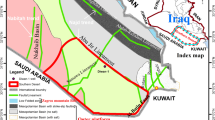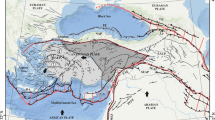Abstract—
Seismic zoning maps of Azerbaijan, compiled using the genetic (seismotectonic) method, are analyzed. The peculiarities of this method are considered as applied to a fault along its length. The genetic method is based on the assumption that at each point of an active (seismogenic) tectonic fault, an earthquake can occur with a magnitude (M) equal to the maximum magnitude (Mmax) of a recorded earthquake. To identify the source zones of strong earthquakes, the author developed a method for determining seismogenic (active) zones of deep tectonic faults from weak seismicity. This method and the available data on the activity of deep-seated tectonic faults were used to assess the seismic hazard of Azerbaijan and adjacent territory of southern Russia. It has been established that seismic shaking on the surface of the territory regional study is of wide differentiation in space according to the degree of its manifestation.




Similar content being viewed by others
REFERENCES
M. A. Alekseevskaya, A. M. Gabrielov, A. D. Gvishiani, I. M. Gelfand, and E. Ya. Rantsman, “Morphostructural zoning of mountain territories by formal criteria,” in Pattern Recognition and Spectral Analysis in Seismology, Ed. by V. I. Kelis-Borok (Nauka, Moscow, 1977), pp. 33–49 [in Russian].
F. S. Akhmedbeili, Neotectonics and Some Aspects of Late Orogenic Geodynamics of Azerbaijan (Nafta-Press, Baku, 2004) [in Russian].
F. S. Akhmedbeili, A. G. Gasanov, F. T. Kuliev, and B. M. Panakhi, “New schemes of source areas of the strongest earthquakes and seismic zoning of Azerbaijan,” in Catalog of Seismic Prediction Observations in the Territory of Azerbaijan in 2011 (Elm, Baku, 1991), pp. 62–68.
F. S. Akhmedbeili, F. T. Kuliev, and E. Sh. Shikhalibeili, Regional seismic zoning of the territory of the USSR. Azerbaijan, in Seismic Zoning of the Territory of USSR (Nauka, Moscow, 1980), pp. 137–147.
B. A. Borisov, “Strong earthquakes in Eastern Caucasus: Interpretation of historical data and analysis of geological environment,” Fiz. Zemli, No. 9, 107–122 (1982).
B. A. Borisov, G. I. Reisner, and V. N. Sholpo, Identification of Seismically Hazardous Zones in an Alpine Fold Area from Geological Data (Nauka, Moscow, 1975) [in Russian].
G. A. Gamburtsev, “The state and perspectives of earthquake prediction studies,” Byull. Soveta Seismol., No. 1, 7–14 (1955).
A. D. Gvishiani and A. A. Soloviev, “On the concentration of major earthquake sources to the interactions of morphostructural lineaments in South America,” in Computational Seismology. Vol. 13: Interpretation of Seismological Data: Methods and Algorithms, Ed. by V. I. Keilis-Borok and A. L. Levshin (Nauka, Moscow, 1981), pp. 46–50 [in Russian].
I. M. Gelfand, Sh. A. Guberman, M. L. Izvekova, V. I. Keilis-Borok, and E. Ya. Rantsman, “On the criteria of high seismicity,” Dokl. Akad. Nauk SSSR 202 (6), 1317–1320 (1972).
A. I. Gorshkov, “Recognition of strong earthquake prone areas in the Alpine–Himalayan belt,” in Computational Seismology, Vol. 40 (Nauka, Moscow, 2010).
I. E. Gubin, “Geology and earthquakes,” in Seismotectonics of Southern Regions of the USSR, Ed. by I. E. Gubin (Nauka, Moscow, 1978), pp. 5–26 [in Russian].
I. E. Gubin, “Seismotectonic Method of Seismic Zoning,” in Trans. Geol. Inst. USSR Acad. Sci. (Nauka, Moscow, 1950), Vol. 140, Ch. 13, pp.1–53.
M. P. Zhidkov and V. G. Kosobokov, “Recognition of probable strong earthquake prone areas. Vol.XIII. Intersection of lineaments of the east of Central Asia,” in Computational Seismology. Vol. 11: Interpretation of Seismological and Tectonic Data, Ed. by V. I. Keilis-Borok (Nauka. Moscow, 1978), pp. 48–71 [in Russian].
Earthquakes in the USSR in 1990, Ed. by N. V. Kondorskaya (Inst. Fiz. Zamli Ross. Akad. Nauk, Moscow, 1996) [in Russian].
The 1 : 1 000 000 Map of the Deep Structure of the Black Sea–South Caspian Region of Regional Deflection, Ed. by K. M. Kerimov and E. Sh. Shikhalibeili (Nafta-Press, Baku, 1992) [in Russian].
F. T. Kuliev, “Equation of macroseismic field for Azerbaijan and its geotectonic regions,” in Seismological Bulletin of the Caucasus, Ed. by V. G. Papalashvili (Metsniereba, Tbilisi, 1987), pp. 129–140 [in Russian].
F. T. Kuliev, Sh. S. Ragimov, and F. S. Akhmedbeili, “Regional seismic zoning of the territory of USSR. Vol. V: Azerbaijan,” in Seismic Zoning of the Territory of USSR (Nauka, Moscow, 1968), pp. 227–241.
T. Ya. Mammadli, “Activity of deep faults in Azerbaijan,” in Catalog of Seismic Prediction Observations in the Territory of Azerbaijan for 2002 (Elm, Baku, 2003), pp. 30–41.
T. Ya. Mammadli, “Revealing source zones of strong earthquakes of Azerbaijan and determination of their maximum magnitudes (M max) from weak seismicity,” Izv. Nats. Akad. Nauk. Azerb., Nauki Zemle, No. 4, pp. 60–64 (2005).
T. Ya. Mammadli, “A new method for revealing the sources of strong earthquakes and determining their maximum magnitudes (M max) from weak seismicity (on the example of Azerbaijan),” in Proceedings of the XVII All-Russian Conference with International Participation. September 20–24, 2011, Voronezh–Moscow (Inst. Fiz. Zemli, Moscow, 2011), pp. 337–341.
A. A. Nikonov, “The strongest earthquake in the Greater Caucasus on January 14, 1668,” Fiz. Zemli, No. 9, 90–106 (1982).
New Catalog of Strong Earthquakes in the USSR from Ancient Times till 1977, Ed. by N. V. Kondorskaya and N. V. Shebalin (Nauka, Moscow, 1977) [in Russian].
T. P. Polyakova, Seismicity of the Central Mediterranean Belt (Nauka, Moscow, 1985) [in Russian].
E. A. Rantsman, Earthquake Locations and Morphostructure of Mountain Countries (Nauka, Moscow, 1979) [in Russian].
Yu. V. Riznichenko, “Problems of seismic hazard at a new stage,” Izv. Akad. Nauk SSSR. Fiz. Zemli, No. 4, 3–14 (1970).
Yu. V. Riznichenko, “Dimensions of a crustal earthquake source and an earthquake moment,” in Studies on the Physics of Earthquakes (Nauka, Moscow, 1976), pp. 9–27.
E. A. Rogozhin, “Tectonics of source zones of strong intracontinental earthquakes,” in Seismicity and Seismic Zoning of North Eurasia (Nauka, Moscow, 1993), pp. 217–227.
Seismological Bulletin (each ten days) August 11–20, 1992. Geophysical Survey RAS, Central Experimental and Methodological Expedition, Obninsk.http://zeus. wdcb.ru/wdcb/sep/hp/seismology.ru/bul_Obninsk.ru. shtml.
A. A. Soloviev, A. D. Gvishiani, A. I. Gorshkov, M. N. Dobrovolsky, and O. V. Novikova, “Recognition of earthquake-prone areas: Methodology and analysis of the results,” Izv., Phys. Solid Earth 50 (2), 151–168 (2014).
V. I. Ulomov and M. I. Bogdanov, A New Series of Maps of General Seismic Zoning of the Territory of the Russian Federation (GSZ-2012), 2015. http://seismos-u.ifz.ru/ p/ulomov-bogdanov.pdf.
V. E. Khain and A. N. Shardanov, Geological History and Structure of the Kura Basin (Akad. Nauk Azerb. SSR, Baku, 1952) [in Russian].
N. V. Shebalin, Sources of Strong Earthquakes in the USSR Territory (Nauka, Moscow, 1974) [in Russian].
N. V. Shebalin, Strong Earthquakes. Selective Works (Akad. Gorn. Nauk, Moscow, 1997) [in Russian].
E. Sh. Shikhalibeili, Some Problematic Issues of the Geological Structure and Tectonics of Azerbaijan (Elm, Baku, 1996) [in Russian].
E. Sh. Shikhalibeili and A. G. Gasanov, “Tectonics of the Kura intermontane trough,” in Reports of Azerbaijan Geologists on the Project “Global Correlation of Epochs of Tectonogenesis” (Baku: Akad. Nauk Azerb. SSR, 1979), pp. 46–54.
M. A. Alekseevskaya, A. M. Gabrielov, A. D. Gvishiani, I. M. Gelfand, and E. Ya. Ranzman, “Formal morphostructural zoning of mountain territories,” J. Geophys. 43, 227–233 (1977).
P. Bazzurro and C. A. Cornell, “Disaggregation of seismic hazard,” Bull. Seism. Soc. Am. 89 (2), 501–520 (1999).
M. Caputo, V. Keilis-Borok, E. Oficerova, E. Ranzman, I. Rotwain, and A. Solovjeff, “Pattern recognition of earthquake-prone areas in Italy,” Phys. Earth Planet. Int. 21, 305–320 (1980).
L. Danciu, K. Şeşetyan, M. Demircioglu, L. Gülen, M. Zare, R. Basili, A. Elias, Sh. Adamia, N. Tsereteli, H. Yalçın, M. Utkucu, M. A. Khan, M. Sayab, Kh. Hessami, A. N. Rovida, M. Stucchi, J.-P. Burg, A. Karakhanian, H. Babayan, Mh. Avanesyan, T. Mammadli, M. Al-Qaryouti, D. Kalafat, O. Varazanashvili, M. Erdik, and D. Giardini, “The 2014 earthquake model of the Middle East: Seismogenic sources,” Bull. Earthquake Eng. 16 (8), 3465–3496 (2018).
I. M. Gelfand, Sh. Guberman, M. L. Izvekova, V. I. Keilis-Borok, and E. Ia. Ranzman, “Criteria of high seismicity determined by pattern recognition,” Tectonophysics 13 (1–4), 415–422 (1972).
“Global seismic hazard assessment program,” Ann. Geofiz. 42 (6), 957–1230 (1999).
A. Gorshkov, V. Kosobokov, and A. Soloviev, “Recognition of earthquake-prone areas,” in Nonlinear Dynamics of the Lithosphere and Earthquake Prediction, Ed. by V. I. Keilis-Borok (Springer, Berlin–Heidelberg, 2003), pp. 239–310.
A. I. Gorshkov, G. F. Panza, A. A. Soloviev, A. Aoudia, and A. Peresan, “Delineation of the geometry of nodes in the Alps: Dinarides hinge zone and recognition of seismogenetic nodes,” Terra Nova 21, 257–264 (2009).
A. I. Gorshkov, G. F. Panza, A. A. Soloviev, and A. Aoudia, “Idendification of seismogenetic nodes in the Alps and Dinarides,” Boll. Soc. Geol. Ital. 123 (1), 3–18 (2004).
A. I. Gorshkov, A. A. Solovev, M. J. Jimenez, M. Garsia-Fernandez, and G. F. Panza, “Recognition of earthquake-prone areas (M ≥ 5.0) in the Iberian Peninsula,” Rend. Lincei 21 (2), 131–162 (2010).
T. Y. Mammadli and E. A. Rogozhin, “On tectonic character of the connection zones of the Earth’s crust in the South Caspian basin and Scythian–Turanian plate based on seismological data,” Seismic Instruments 53 (2), 124–133 (2017).
T. Y. Mammadli and E. A. Rogozhin, “Transverse faults of the Eastern Caucasus and their manifestations in seismicity,” Seismic Instruments 55 (2), 220–228 (2019).
K. Şeşetyan, L. Danciu, M. B. Demircioglu, D. Tümsa, D. Giardini, M. Erdik, S. Akkar, L. Gülen, M. Zare, Sh. Adamia, A. Ansari, A. Arakelyan, A. Askan, M. Avanesyan, H. Babayan, T. Chelidze, R. Durgaryan, A. Elias, H. Hamzehloo, Kh. Hessami, D. Kalafat, Ö. Kale, A. Karakhanyan, M. A. Khan, T. Mammadli, M. Al-Qaryouti, M. Sayab, N. Tsereteli, M. Utkucu, O. Varazanashvili, M. Waseem, H. Yalçın, and M. T. Yılmaz, “The 2014 seismic hazard model of the Middle East: An overview and results,” Bull. Earthquake Eng. 16 (8), 3535–3566 (2018).
M. N. Toksoz, A. F. Shakal, and A. J. Michael, “Space-time migration of earthquakes along the North Anatolian fault zone and seismic gaps,” Pure Appl. Geophys. 117, 1258–1270 (1979).
T. Utsi, “A statistical study on the occurrence of aftershocks,” Geophys. Mag. 30 (4), 521–605 (1961).
USGS. Significant Earthquakes of the World 1991. https://earthquake.usgs.gov/earthquakes/browse/significant.php?year=1991. Accessed July 14, 2021.
ACKNOWLEDGMENTS
The author acknowledges Prof. E.A. Rogozhin (Schmidt Institute of Physics of the Earth, Russian Academy of Sciences, Moscow, Russia) for helpful discussions. This article is dedicated to the memory of E.A. Rogozhin, who passed away during the initial stages of the study.
Funding
The study was supported by the Presidential Foundation for Science Development of the Republic of Azerbaijan, grant no. EIF-BGM-4-RFTF-1/2017-21/17/2.
Author information
Authors and Affiliations
Corresponding author
Ethics declarations
The authors declare that they have no conflicts of interest.
Additional information
Translated by N. Astafiev
Rights and permissions
About this article
Cite this article
Mammadli, T.Y. Determination of Seismogenic Zones for Analysis of Seismotectonic Activity of Deep Faults: Seismic Hazard Assessment for the Territory of Azerbaijan. Geotecton. 56, 191–199 (2022). https://doi.org/10.1134/S0016852122020042
Received:
Revised:
Accepted:
Published:
Issue Date:
DOI: https://doi.org/10.1134/S0016852122020042




